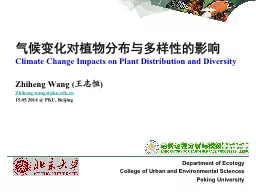PPT-气候变化对 植物 分布与多样性的影响
Author : hirook | Published Date : 2020-08-28
Climate Change Impacts on Plant Distribution and Diversity Zhiheng Wang 王志恒 Zhihengwangpkueducn 15052014 PKU Beijing Department of Ecology College of Urban
Presentation Embed Code
Download Presentation
Download Presentation The PPT/PDF document "气候变化对 植物 分布与多样�..." is the property of its rightful owner. Permission is granted to download and print the materials on this website for personal, non-commercial use only, and to display it on your personal computer provided you do not modify the materials and that you retain all copyright notices contained in the materials. By downloading content from our website, you accept the terms of this agreement.
气候变化对 植物 分布与多样性的影响: Transcript
Download Rules Of Document
"气候变化对 植物 分布与多样性的影响"The content belongs to its owner. You may download and print it for personal use, without modification, and keep all copyright notices. By downloading, you agree to these terms.
Related Documents

